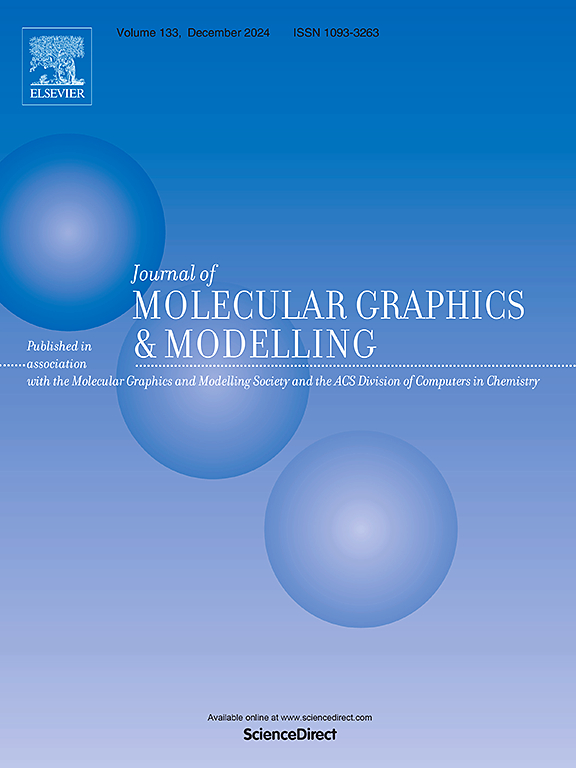GaAs量子点与5CB液晶分子相互作用的DFT研究。
IF 2.7
4区 生物学
Q2 BIOCHEMICAL RESEARCH METHODS
引用次数: 0
摘要
液晶由于其双折射、介质各向异性和对外部场的响应特性而被广泛应用于各种光学器件中。通过掺杂纳米粒子(包括半导体量子点)来增强现有lc的性能,为改善其性能提供了一条有前途的途径。在各种纳米粒子中,量子点以其高电荷迁移率、近红外光谱区的灵敏度和成本效益而脱颖而出。这些属性使它们成为与lc集成的理想候选者。虽然液晶行为源于分子的集体有序,但量子点和LC分子之间的微观相互作用仍然是一个有趣的研究领域,以了解潜在的量子级机制。在本研究中,我们运用密度泛函理论研究了砷化镓量子点与5CB分子之间的相互作用。将5CB分子与Ga原子逐渐聚到一起,计算相应的相互作用能和电子密度分布的变化。能量谱显示了明显的距离依赖相互作用,最小值为2.1 Å,表明形成了稳定的配合物。BVP86功能略微高估了相互作用能,而B3LYP功能得到的结果更准确,证实了稳定量子点- 5CB分子复合物的可行性。本文章由计算机程序翻译,如有差异,请以英文原文为准。

DFT study of GaAs quantum dot and 5CB liquid crystal molecule interaction
Liquid crystals (LC) are widely used in various optical devices due to their birefringence, dielectric anisotropy, and responsive behavior to external fields. Enhancing the properties of existing LCs through doping with nanoparticles, including semiconductor quantum dots, offers a promising route for improving their performance. Among various nanoparticles, QDs stand out for their high charge mobility, sensitivity in the near-infrared spectral region, and cost-effectiveness. These attributes make them ideal candidates for integration with LCs. While liquid crystalline behavior arises from the collective ordering of molecules, the microscopic interactions between QDs and LC molecules remain an intriguing area of study to understand the underlying quantum-level mechanisms.
In this study, we employ Density Functional Theory to investigate the interaction between GaAs quantum dot and a 5CB molecule. The 5CB molecule and Ga atoms were brought together gradually, and the corresponding changes in interaction energy and electron density distributions were calculated. The energy profiles reveal a clear distance-dependent interaction, with a minimum observed at 2.1 Å, indicating the formation of stable complexes. While the BVP86 functional slightly overestimated the interaction energy, the B3LYP functional produced more accurate results, confirming the feasibility of stable quantum dot – 5CB molecule complexes.
求助全文
通过发布文献求助,成功后即可免费获取论文全文。
去求助
来源期刊

Journal of molecular graphics & modelling
生物-计算机:跨学科应用
CiteScore
5.50
自引率
6.90%
发文量
216
审稿时长
35 days
期刊介绍:
The Journal of Molecular Graphics and Modelling is devoted to the publication of papers on the uses of computers in theoretical investigations of molecular structure, function, interaction, and design. The scope of the journal includes all aspects of molecular modeling and computational chemistry, including, for instance, the study of molecular shape and properties, molecular simulations, protein and polymer engineering, drug design, materials design, structure-activity and structure-property relationships, database mining, and compound library design.
As a primary research journal, JMGM seeks to bring new knowledge to the attention of our readers. As such, submissions to the journal need to not only report results, but must draw conclusions and explore implications of the work presented. Authors are strongly encouraged to bear this in mind when preparing manuscripts. Routine applications of standard modelling approaches, providing only very limited new scientific insight, will not meet our criteria for publication. Reproducibility of reported calculations is an important issue. Wherever possible, we urge authors to enhance their papers with Supplementary Data, for example, in QSAR studies machine-readable versions of molecular datasets or in the development of new force-field parameters versions of the topology and force field parameter files. Routine applications of existing methods that do not lead to genuinely new insight will not be considered.
 求助内容:
求助内容: 应助结果提醒方式:
应助结果提醒方式:


